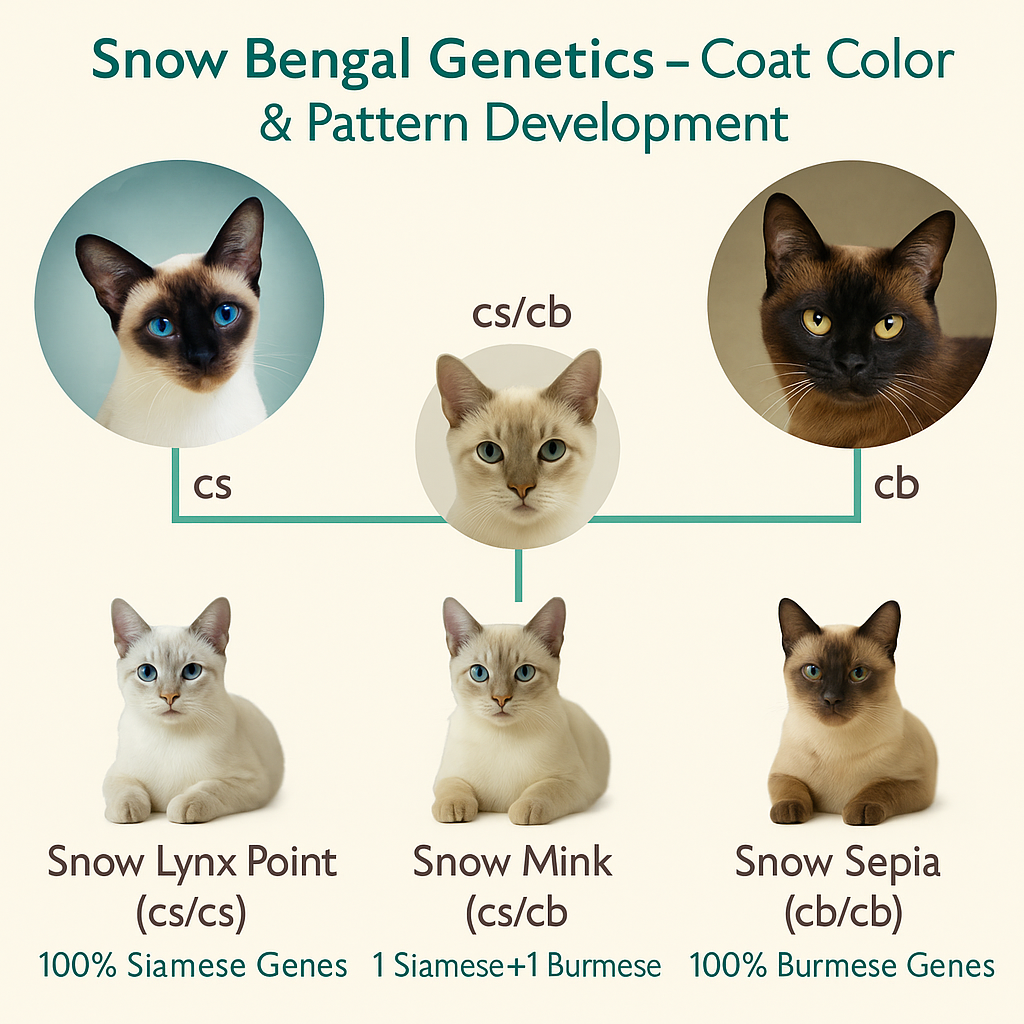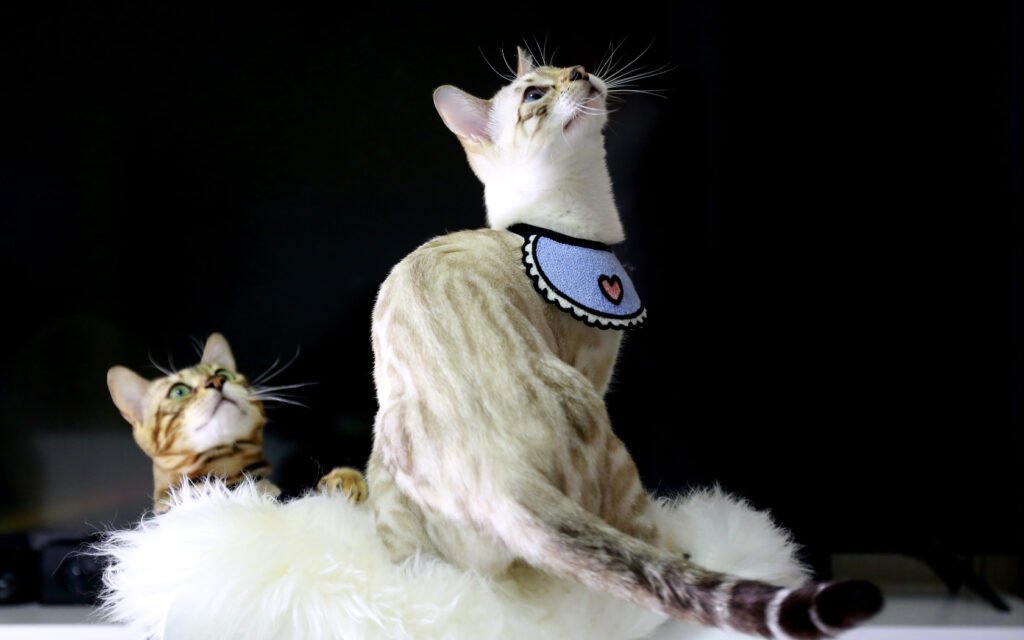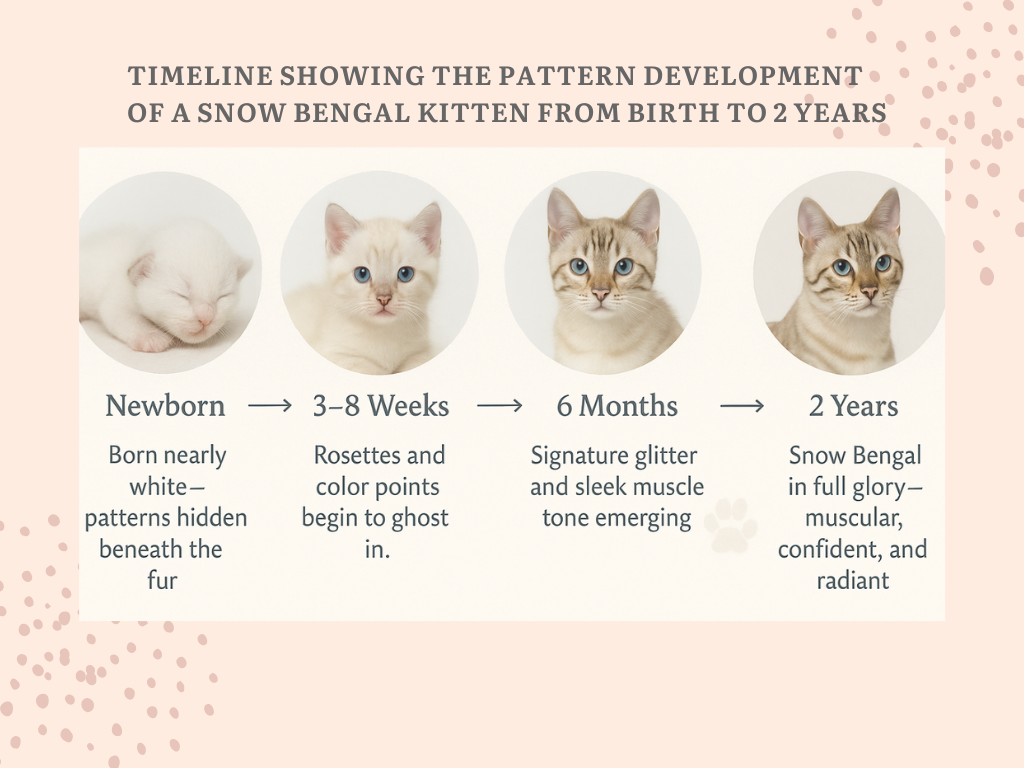The Ethereal Beauty of the Snow Bengal
The Snow Bengal cat represents one of the most visually striking variations of the Bengal breed. Unlike their warm-toned golden, brown, or silver siblings, Snow Bengals showcase their spectacular rosettes and patterns against a dramatically lighter background. This creates an almost otherworldly contrast that many enthusiasts find irresistible.
My first encounter with a Snow Bengal was at a cat show in 2008 – a stunning Seal Lynx Point male whose ice-blue eyes seemed to pierce right through me. His pristine white coat displayed subtle markings that reminded me of paw prints in freshly fallen snow. That meeting sparked my fascination with these remarkable cats, eventually leading me to welcome several Snow Bengals into my home over the years.
What many people don’t realize is that “Snow Bengal” isn’t a single color variation – it’s actually three distinct types, each with unique characteristics: Snow Lynx Point, Snow Mink, and Snow Sepia. The differences between them stem directly from fascinating genetic combinations that influence everything from coat pattern to eye color.
Understanding the Genetics: Colorpoint Alleles (cs, cb)
To truly appreciate Snow Bengals, we need to understand the genetic foundation that creates these beautiful cats. The Snow Bengal’s distinctive appearance comes from the interaction of specific colorpoint alleles in the cat’s genetic makeup.
The standard Bengal coloration (brown, silver, etc.) is modified by two key recessive genes from the Siamese and Burmese breeds:
- Colorpoint Siamese gene (cs): Creates the temperature-sensitive coloration pattern seen in Siamese cats
- Colorpoint Burmese gene (cb): Produces the sepia coloration pattern seen in Burmese cats
These genes affect melanin production in the cat’s body, particularly in a temperature-sensitive way. The cooler parts of the body (face, ears, paws, and tail) develop darker coloration, while warmer areas remain lighter. This explains why Snow Bengals often have more pronounced markings on their extremities.

The fascinating part is how these genes combine to create the three distinct Snow Bengal types:
- Snow Lynx Point (cs/cs): Two copies of the Siamese gene
- Snow Mink (cs/cb): One copy of the Siamese gene, one copy of the Burmese gene
- Snow Sepia (cb/cb): Two copies of the Burmese gene
This genetic diversity explains why not all “white Bengal cats” look the same – they’re actually expressing different genetic combinations that affect coat contrast, pattern development, and even eye color.
Seal Lynx Point (cs/cs): Characteristics (Blue Eyes, Faint Markings)
The Snow Lynx Point Bengal, carrying two copies of the Siamese colorpoint gene (cs/cs), is perhaps the most striking and immediately recognizable of the Snow Bengal varieties.
Defining Characteristics:
- Eye Color: Always a vivid, deep blue – similar to Siamese cats
- Coat Base: The lightest background of all Snow Bengals, often appearing almost white, especially at birth
- Markings: Displays the most temperature-sensitive coloration, with markings that develop gradually and remain most visible on the cooler extremities (face, ears, legs, and tail)
- Pattern Development: Kittens are often born nearly white and develop their markings gradually over the first few weeks to months of life
One of the most remarkable aspects of Snow Lynx Bengals is how dramatically their appearance changes as they mature. I’ve raised several Snow Lynx kittens who looked almost completely white at birth, with just the faintest hint of markings on their faces. By 2-3 years of age, these same cats developed gorgeous seal brown patterns that stood out beautifully against their cream-colored bodies.
The temperature-sensitive nature of their coloration means that Snow Lynx Bengals living in warmer climates often show less contrast than those in cooler environments. During winter months, you might notice your Snow Lynx Bengal’s markings becoming more pronounced across their entire body.

When identifying a Snow Lynx Bengal, the blue eyes are your most reliable indicator. While the coat pattern can vary in intensity, those piercing blue eyes are a genetic certainty in this variety.
Seal Mink (cs/cb): Characteristics (Aqua Eyes, Moderate Contrast)
The Snow Mink Bengal, carrying one copy each of the Siamese and Burmese genes (cs/cb), offers a beautiful middle ground between the other two Snow varieties. This genetic combination produces some of the most unique and captivating features in the Bengal world.
Defining Characteristics:
- Eye Color: Distinctive aqua or blue-green – a truly unique feature that’s often described as “aquamarine” or “turquoise”
- Coat Base: Ivory to light tan background, darker than Lynx but lighter than Sepia
- Markings: Moderate contrast with defined patterns that are visible across the body, though still somewhat more pronounced on extremities
- Pattern Development: Born with more visible markings than Lynx, but still develops additional contrast with age
The aqua eyes of a Snow Mink Bengal are perhaps their most captivating feature. I’ve had visitors become completely mesmerized by my Snow Mink Bengal’s unusual eye color – neither blue like the Lynx nor gold/green like the Sepia, but a stunning aqua tone that seems to change slightly depending on the lighting.
In my experience, Snow Mink Bengals often have the most balanced appearance of the three varieties. Their patterns are clearly visible from birth but continue to develop beautiful contrast as they mature. The temperature-sensitive aspects of their coloration are less dramatic than in Lynx Points but still noticeable.
The Snow Mink Bengal represents a perfect intermediate in terms of contrast – not as subtle as the Lynx, but not as bold as the Sepia. This makes them particularly photogenic cats that showcase their wild Bengal heritage beautifully.
Seal Sepia (cb/cb): Characteristics (Gold/Green Eyes, Highest Contrast Snow)
The Snow Sepia Bengal, carrying two copies of the Burmese colorpoint gene (cb/cb), presents the boldest and most dramatic pattern of all the Snow varieties. These cats represent the “high contrast” option among Snow Bengals.
Defining Characteristics:
- Eye Color: Gold to green – similar to standard Bengals
- Coat Base: Cream to light tan background, the darkest of the Snow varieties
- Markings: Highest contrast with rich, dark patterns clearly visible across the entire body
- Pattern Development: Born with well-defined markings that continue to darken and develop with age
I’ve often found that Snow Sepia Bengals appeal to those who want the distinctive look of a light-colored Bengal without sacrificing the bold pattern definition that makes Bengals so special. My Snow Sepia, Jasper, has always drawn attention for his remarkably clear rosettes that stand out dramatically against his cream-colored coat.
Unlike the more temperature-sensitive Lynx Points, Snow Sepia Bengals maintain consistent pattern visibility regardless of ambient temperature. Their markings are uniformly distributed rather than concentrated on the extremities, giving them a more even appearance overall.
Another distinguishing feature is their eye color. While many expect all Snow Bengals to have blue eyes, Sepias have gold to green eyes that more closely resemble standard Bengal coloration. This can sometimes lead to confusion when identifying Bengal varieties, as people might not immediately recognize a Sepia as a “Snow” without understanding the genetics behind these beautiful cats.
Identifying the Differences (Implement linkable comparative chart)
When trying to determine which type of Snow Bengal you’re looking at (or considering adding to your family), understanding the key visual differences between the three varieties is essential. Here’s a comparative breakdown:
| Feature | Snow Lynx Point (cs/cs) | Snow Mink (cs/cb) | Snow Sepia (cb/cb) |
|---|---|---|---|
| Eye Color | Blue | Aqua/Blue-Green | Gold/Green |
| Coat Base | Whitest background | Ivory to light tan | Cream to light tan |
| Marking Contrast | Lightest, most concentrated on extremities | Moderate, visible across body | Highest contrast, even distribution |
| Pattern Development | Born nearly white, slow development | Born with visible markings that develop further | Born with well-defined markings |
| Temperature Sensitivity | Highly temperature-sensitive | Moderately temperature-sensitive | Minimally temperature-sensitive |
In my years working with Snow Bengals, I’ve found that identifying the variety correctly often comes down to examining two key factors: eye color and pattern distribution. While coat color can vary somewhat within each variety, the eye color is a reliable genetic marker that helps distinguish between types.
Here’s a practical tip I’ve learned: if you’re trying to identify a Snow Bengal and can’t immediately tell which variety it is, look first at the eyes, then at how the markings are distributed. If the markings are primarily concentrated on the face, ears, legs and tail with a very light body, you’re likely looking at a Lynx Point. If the markings are clear and evenly distributed with gold/green eyes, it’s probably a Sepia. Anything in between with aqua eyes is your classic Mink.
Ghost Markings and Pattern Development in Snow Kittens
One of the most fascinating aspects of Snow Bengals is how their patterns develop and change over time – a phenomenon particularly pronounced in Snow Lynx and, to a lesser extent, Snow Mink varieties.
“Ghost markings” is the term Bengal enthusiasts use to describe the faint, barely-visible patterns seen on very young Snow kittens, particularly Lynx Points. These subtle markings are often barely perceptible at birth but gradually become more defined as the kitten matures.
The development timeline typically follows this pattern:
- Birth to 2 weeks: Snow Lynx kittens appear almost completely white, with only the faintest hint of facial markings. Snow Mink kittens show light but visible patterns. Snow Sepia kittens already display clear markings.
- 2-8 weeks: Ghost markings become increasingly visible. Temperature-sensitive coloration begins to develop more noticeably on extremities.
- 2-12 months: Dramatic pattern development occurs during this period, with markings becoming increasingly defined.
- 1-3 years: Full adult coloration develops, with maximum contrast achieved typically by 3 years of age.
I’ve documented this fascinating transformation with several of my own Snow Bengal kittens. My Snow Lynx, Avalanche, was so white at birth that visitors often didn’t believe he was a Bengal at all. By three years of age, he had developed stunning seal brown rosettes that contrasted beautifully against his cream-colored body.

For new Snow Bengal owners, understanding this developmental process is crucial. I often remind them: “What you see is not what you’ll get!” Particularly with Snow Lynx Bengals, patience is required to see the full glory of their adult patterns emerge.
A word of caution when selecting a Snow Bengal kitten: reputable breeders should be able to show you the parents and explain the expected pattern development. Be wary of claims about final pattern appearance, especially in very young Lynx Point kittens, as their development can be unpredictable.
Visual Gallery: Lynx vs. Mink vs. Sepia Examples
While written descriptions are helpful, nothing beats seeing the differences between Snow Bengal varieties with your own eyes. Let me share some observations about each type based on the hundreds of Snow Bengals I’ve encountered over the years.
Snow Lynx Point Bengals:
- The blue eyes are always striking and unmistakable
- The contrast between face markings and body can be dramatic
- The body often has a lustrous, pearly white appearance
- Patterns are typically most visible on the face, tail, and legs
Snow Mink Bengals:
- The aqua eyes create an almost mystical appearance
- The overall look is often described as “softly defined”
- The body color creates a beautiful ivory canvas for patterns
- The contrast level strikes a perfect balance – not too subtle, not too bold
Snow Sepia Bengals:
- The gold/green eyes provide a warm contrast to the cool coat colors
- The rich, dark markings stand out dramatically
- The overall impression is bold and striking
- The even pattern distribution creates a harmonious appearance
Each variety has its devoted fans. I’ve found that those seeking the most dramatic “white Bengal cat” appearance often prefer the Lynx Point, while those who want more visible patterns might lean toward the Sepia. The Mink, with its unique aqua eyes and moderate contrast, often appeals to those who appreciate subtlety and distinction.
Conclusion: Choosing or Identifying Your Snow Bengal
Whether you’re trying to identify which Snow Bengal variety you’ve encountered or deciding which type might be the perfect addition to your family, understanding these distinctions helps you appreciate the unique qualities of each.
In my experience, Snow Bengals of all varieties share the quintessential Bengal personality: active, intelligent, playful, and devoted. Their color variation doesn’t affect their temperament or health – it simply adds another dimension to their already fascinating nature.
If you’re considering adding a Snow Bengal to your family, I recommend spending time with different varieties if possible. Pay attention to which visual characteristics appeal to you most – the ethereal, blue-eyed beauty of the Lynx Point, the balanced, aqua-eyed elegance of the Mink, or the bold, gold-eyed clarity of the Sepia.
Remember that all Snow Bengals require the same care as standard Bengals: plenty of exercise, mental stimulation, high-quality nutrition, and regular veterinary check-ups. Their striking appearance comes with the same Bengal energy and intelligence that makes this breed so special.
I hope this guide has helped illuminate the fascinating world of Snow Bengals. These remarkable cats are truly living art, combining the wild beauty of their Asian Leopard Cat heritage with the enchanting palette of snow and frost.
Have you encountered Snow Bengals in your life? Do you have questions about these beautiful cats? Share your experiences or questions in the comments below!
Frequently Asked Questions
Q: How can I tell the difference between a Snow Lynx, Mink, and Sepia Bengal?
A: The most reliable distinguishing feature is eye color: Snow Lynx Bengals have blue eyes, Snow Mink Bengals have aqua/blue-green eyes, and Snow Sepia Bengals have gold/green eyes. Additionally, Lynx Points have the lightest base color with markings concentrated on extremities, Minks have moderate contrast with visible body patterns, and Sepias have the highest contrast with bold, evenly distributed markings.
Q: Which Snow Bengal type has blue eyes?
A: The Snow Lynx Point Bengal (cs/cs) is the only Snow Bengal variety that consistently has blue eyes. Snow Minks have aqua or blue-green eyes, and Snow Sepias have gold to green eyes. The blue eye color in Snow Lynx Bengals is directly linked to their genetic makeup, carrying two copies of the Siamese colorpoint gene.
Q: Are Snow Bengals born white? How does their color develop?
A: Snow Lynx Bengals are typically born almost white with very faint “ghost markings.” Snow Mink and Snow Sepia Bengals are born with more visible patterns. All Snow Bengals, especially Lynx Points, continue to develop their coloration for up to 3 years, with markings becoming progressively more defined. Temperature-sensitive coloration means that cooler parts of the body develop darker markings first.
Q: Is the Snow variation related to albinism?
A: No, Snow Bengals are not albinos. While albinism is caused by a complete lack of melanin production, Snow Bengals have normal melanin production that is partially inhibited by temperature-sensitive genes. Snow Bengals have pigmented eyes and develop colored markings, unlike true albino animals which have red or pink eyes and no pigmentation. The Snow Bengal’s coloration comes from specific colorpoint genes (cs and cb) inherited from Siamese and Burmese ancestors.
Disclaimer: While I’ve shared information based on my experience and research, this article is for educational purposes only. For specific health concerns or breeding questions about your Bengal cat, always consult with a qualified veterinarian who specializes in feline care.









